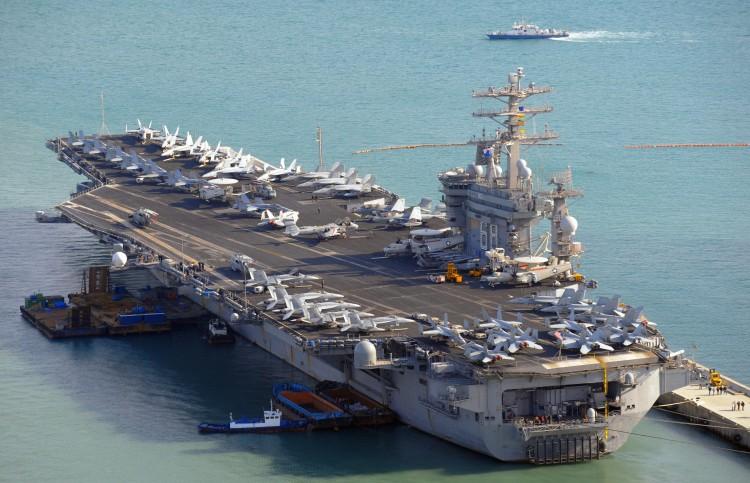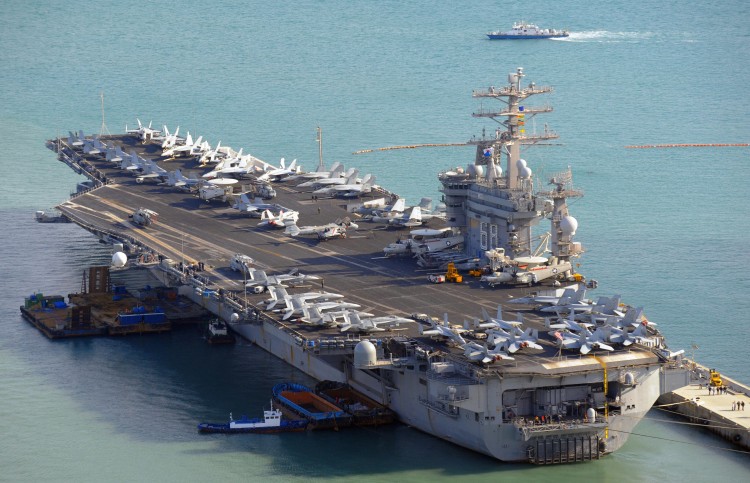The U.S. Navy’s Great Green Fleet could push our military into a new strategy that increases our combat readiness and resilience. The fleet will be powered by a 50–50 blend of conventional and alternative biofuels.
The program, started in 2009 by Secretary of the Navy (SECNAV) Ray Mabus, aims to reduce or eliminate an extreme military vulnerability: dependence upon foreign oil.
The Great Green Fleet is one of many ideas instituted by SECNAV Mabus that could change the way the military uses energy. The fleet was named in honor of the Great White Fleet, which helped establish the United States as a world power under the administration of President Theodore Roosevelt in the early 20th century.
“The Navy has always valued energy as a tactical and strategic resource,” a Navy official told The Epoch Times in an email. “It was the Navy that went from wind to coal in the 1800s and transformed again to oil in the early 1900s. And in the 1950s, the Navy pioneered nuclear power.”
Currently, the fleet is in the demonstration phase of its operations, which precedes its official deployment in 2016.
“The Great Green Fleet will demonstrate another energy transformation that has the potential to strengthen our energy security by unleashing the military from the tether of oil.”
A demonstration on July 18 will be conducted next week during this year’s Rim of the Pacific event, the world’s largest international maritime exercise. The Great Green Fleet participants will be the USS Nimitz (CVN 68) and Carrier Air Wing Eleven, the USS Chafee (DDG 90), the USS Chung Hoon (DDG 93), the USS Princeton (CG 59), and the USNS Henry J Kaiser (T-AO 187).
“It’s a multination exercise, a test for aircraft out of a controlled environment,” Navy Lt. Richlyn Neal told The Epoch Times.
The demonstration will further evaluate the efficiency of the alternative fuels, which include nuclear or advanced biofuel blends. The 50–50 mixtures of biofuel are made from used cooking oil, algae, and conventional petroleum-based marine diesel, or aviation fuel.
“The Great Green Fleet provides a great opportunity of operational testing—it is intended to test, evaluate, and demonstrate the cross-platform utility and functionality of advanced biofuels,” said the Navy official. “It essentially serves as the ‘final exam’ for the Navy’s testing and qualification of hydrotreated renewable fuels.”
Navy surface ships will be powered using 350,000 gallons of hydroprocessed renewable diesel (HRD-76) blended with an equal amount of conventional marine diesel.
Aircraft will be powered with 100,000 gallons of hydroprocessed renewable jet fuel (HRJ-5) blended with conventional jet fuel.
Additionally, the fleet will utilize many energy efficiency measures, including LED solid-state lighting, gas turbine online water wash to help reduce fuel consumption, shipboard energy dashboard to view real-time energy demands, Smart Voyage Planning Decision Aid to optimize route mapping, and stern flaps, which will reduce drag and turbulence under the ship.
“By increasing energy efficiency (through technology improvements and behaviors) while at sea, we can achieve greater range and reduce vulnerability by decreasing the frequency of replenishments,” said the Navy official in his email.
“Improving energy efficiency increases combat capability of our war fighters.”
The Epoch Times publishes in 35 countries and in 19 languages. Subscribe to our e-newsletter.






